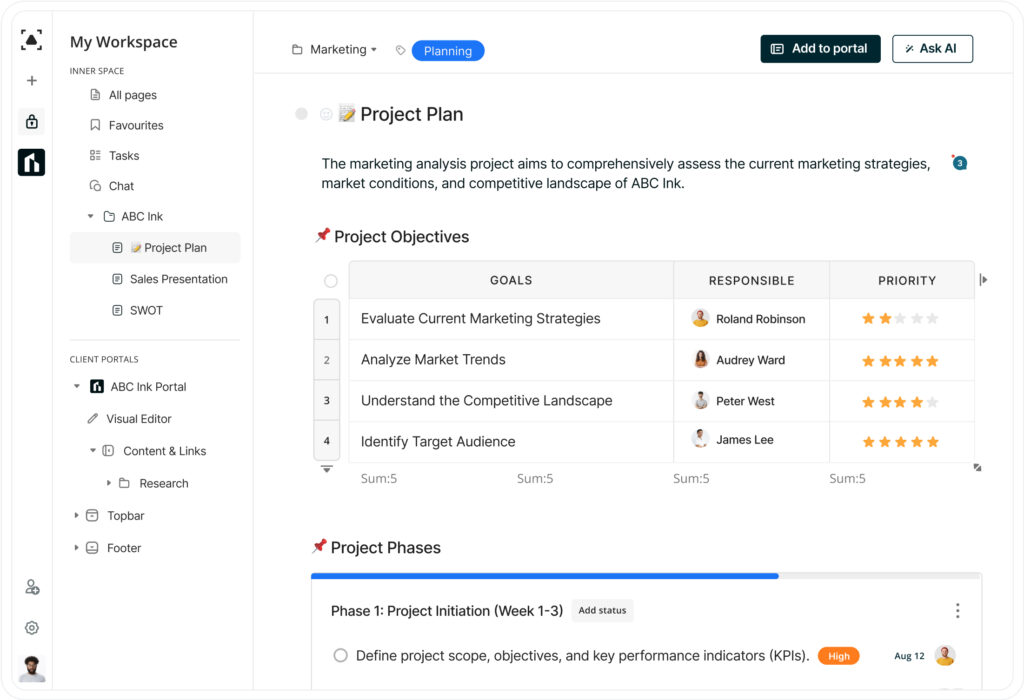
How to Make Your Team Collaboration Strategy Better than Ever
- November 3, 2023
- 10 Min read
Stanford studies claim that employees who work in a collaborative setting are 50% more productive than those who complete tasks individually. Cooperation at work boosts engagement and motivation to achieve a common goal. That’s one of the reasons why you should invest in team collaboration at your workplace. It supports the most critical company values like time, efficiency and proper communication.
If you want to establish well-oiled communication processes and good team collaboration, you’ll need a strategy and a clear vision of what teamwork should look like. Even if your employees are working remotely, standardizing the cooperation format can facilitate completing any project and save extra time.
However, it’s still a long way down the road. According to Harvard Business Review, 40% of managers struggle to manage their remote employees effectively.
So, how do you improve on your collaboration strategy, and what should you do to make it work perfectly for your team? We’ve collected some of the main tips for boosting both on-site and remote teamwork in this post. We’ll also review an effective tool that’ll help ensure transparent communication processes and practical cooperation for teams of any size and format.
What is Team Collaboration and How Does it Benefit Businesses?
Team collaboration is a set of group activities and approaches that facilitate project completion and help achieve better results as a team rather than individually. It ensures smoother communication processes, a more precise division of responsibilities and a constant exchange of knowledge and feedback within a unified system or channel. Team cooperation also helps properly deliver company values and ensure everyone’s on board with them.
One of the main perks of good team collaboration is that it brings team members together to generate new ideas, brainstorm and look at issues from different perspectives. It’s also crucial for cross-department communication and establishing more comfortable, transparent relations between managers/supervisors and subordinates. These factors are essential to promoting the right company values and mindset.
What is team cooperation today?
We’ve gathered some of the major trends of how team collaboration is evolving. Use them as additional company values to ensure you’re maintaining internal collaboration right. You’ll find some insightful outcomes here!
- Smart meeting rooms — you can generate an AR meeting room or add a 360 camera view for those working remotely. It helps create the feeling of presence and complete immersion with the corporate workflow;
- AI and machine learning for cooperation — according to the McKinsey report, 50% of employees say their companies have already implemented AI in at least one business function. This includes notification filters, CoBots that help optimize particular processes and voice assistants that play various roles;
- Cloud-based communication via collaboration tools — this ensures more convenient communication between coworkers from different departments and facilitates the exchange of feedback and ideas with management. Using this type of cooperation fits hybrid or fully remote teams the best — one of the most significant company values is time, so this will work perfectly;
- Corporate social networks — build or incorporate a dedicated tool that’ll make team collaboration a more playful and fun activity than just an assignment you need to complete. Still, your employees will be focusing on work-related topics instead of discussing the latest celebrity news or Apple’s presentations.
Team collaboration vs. individual work
Another reason to root for team collaboration in a startup or other company type is to enhance the completion of individual tasks. Whether you’re working on tech- or marketing-related issues, the team members from your own and other departments will help you out. They can provide valuable feedback and share ideas on how to complete your project or task in a better way.
Plus, cooperation between teammates allows you to look at issues and tasks from different perspectives. It encourages a better generation of ideas and proper communication of skills, tools and company values required for every assignment.
Below, you’ll see a quick comparison showing the main differences between individual work and team collaboration (and what perks you’ll get working with other team members).
Individual work:
- Ensures fast task completion thanks to lack of distractions — this is a responsible individual approach;
- Provides no exchange of knowledge; you generate new ideas on your own;
- Allows brainstorming but lacks of opinions or approval from others;
- Ensures a strong understanding of how the issue needs to be solved;
- Enables autonomy in processing tasks with the feeling of psychological safety for the quality of completed assignments.
At the same time, team collaboration:
- Enables prompt project completion with help from others;
- Ensures massive exchange of knowledge and ideas plus honest feedback from a third party;
- Ensures more effective and rapid brainstorming;
- Helps see the problem and solutions to it from different angles;
- Offers a variety of ways to complete tasks with a wider variety of tools and advice from other departments.
How to Improve Team Collaboration in Your Company
If you want to build a proper communication and practical cooperation channel between all your teammates, take care of providing the appropriate conditions. We’ve prepared some tips on boosting team collaboration in your startup and ensuring proper project completion.
Standardize processes and documents flow
If you want to make sure all of your team members know exactly what to do and have equal access to every file, instruction and guide, think of creating a unified system for standardizing every piece of internal documentation. Yes, you’ll need to create standardized meeting checklists, step-by-step guides and many more to ensure everything’s unified!
Take every piece of information into account: any employee orientation checklist, meeting notes templates, to-do lists and how-to instructions for every task. Also, make sure to make it more engaging and readable: insert bulleted lists, video tutorials, quick notes or comments and screenshots. This way, everyone will understand what the task is about and what they need to do.
Everyone who processes documentation needs to ensure every colleague has access to everything they might need for proper task completion and workflow management.
Creating standardized documentation saves time and gives a feeling of psychological safety for those working on responsible tasks — they can see all the updates in real-time and don’t need to worry if they missed anything in the outlines.
Encourage brainstorming
Not just between your own team members or subordinates but also among departments. Since you’re all working on the same product, you can ensure a constant flow of ideas in different directions: technical, sales, customer-related, marketing, etc. For such company values as innovation and continuous development, brainstorming is key to new opportunities and exciting challenges.
Make sure you provide enough visualization and the feeling of presence for both on-site and remote workers. 22% of employees have noticed a drop in ideation due to the lack of visual connection with the team. Such a decline has been a noticeable trend since the beginning of the Covid pandemic.
Use a unified collaboration tool
Typically, an essential company value is efficiency. This usually comes with wise time and task management.
That’s the main reason to use collaboration tools as they eliminate the need to use messengers, task planners or anything else separately — you’ve got everything stored in one convenient location and don’t waste time searching for the assignment description or comments in your mail or app notifications.
Use a single cooperation tool to create a centralized workplace and reduce distractions caused by switching between various platforms. Both mature companies and startups build several communication channels to deliver tasks. Some of them use Slack, Discord and Messenger simultaneously. Some companies stick to using two solutions at once. Sounds confusing, right?
Creating a unified workplace where you and your teammates can share ideas, allocate tasks, gather all the documentation and provide feedback is a better solution. You can easily communicate with anyone anytime: a person who develops an app, processes documentation, creates standardized meeting notes, designs the website or prepares an orientation checklist.
Plus, you can create notes templates to start discussing new tasks or ideas right away with no need to waste time on useless meetings. Thanks to asynchronous communication, you can be sure your teammates have seen the message and will respond to you at their earliest convenience. No need to send email reminders or start meeting preparations!
Make use of asynchronous communication
Asynchronous communication is a perfect solution for a team that values each other’s time and wants to deliver proper results without excessive pressure and unnecessary meetings.
This strategy proves you don’t need meetings and in-person communication to ensure quality task completion and effective collaboration. 92% of surveyed digital workspace users claim that sharing feedback and ideas via video or chat has become a more common thing than doing so in real-time during corporate calls or in person. Instead of this, create notes templates to start transferring your team to a more digitized, asynchronous type of cooperation.
To make asynchronous communication work, you’ll need to build trust towards your teammates and give them the freedom to answer your requests, feedback and questions whenever they find it more convenient. People might be busy at the time, and you should realize you won’t always get answers right away. This approach facilitates communication and ensures better idea generation with no rush. You can learn more about asynchronous communication here>
Skyrocket Your Team Collaboration with FuseBase

FuseBase is an excellent solution for maintaining company values like efficiency and teamwork. The tool works well for any work format: on-site, remote and hybrid. FuseBase is an innovative service that will ensure proper task completion, cross-department communication, mutual support and increased overall productivity at work.
How can FuseBase help your startup provide knowledge exchange and develop a better collaboration strategy? Take a look at these valuable features — they’ll be your helping hands throughout your work processes.
- Super Documents — gather everything your team needs in one doc: from every employee orientation checklist to meeting notes templates. You can update them and add multiple types of data anytime to ensure clarity and transparency in task allocation;
- Convenient structure — with folders and tags, you can quickly gather information, instructions and tasks for each department separately and communicate assignments to particular team members. You can also collaborate on separate projects within different workspaces. Finally, it’s easy to manage permissions and roles of your team members;
- Video and audio recordings — you can do this right on FuseBase pages. Use this feature to share feedback and ideas with your team members;
- Comments + Chat — ensure transparent communication processes right inside the FuseBase ecosystem. You won’t need to switch between messengers or pay for extra chat services.
FuseBase is a modern, high-end tool for improving your team collaboration strategy. It’s suitable for any startup of any kind and format. This service is an excellent tool for both responsible individual usage and collaboration for effective project management.
Thanks to FuseBase and its advanced functions, you can forget about miscommunication issues and ensure good team collaboration. It helps you share knowledge, create standardized meeting note templates and build a friendlier, collaborative community at work.
Get a free FuseBase trial for your team and business — we know you’ll enjoy it!
Found it useful? Share the article with your community
Subscribe to our blog!
Get weekly tips and insights on how to grow your business